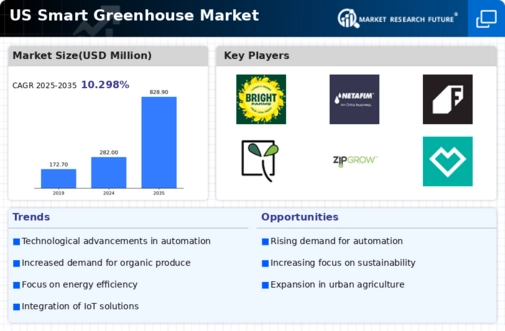The smart greenhouse market is currently characterized by a dynamic competitive landscape, driven by technological advancements and a growing emphasis on sustainable agricultural practices. Key players such as Netafim (US), AeroFarms (US), and BrightFarms (US) are at the forefront, each adopting distinct strategies to enhance their market positioning. Netafim (US) focuses on innovative irrigation solutions, leveraging precision agriculture to optimize water usage, while AeroFarms (US) emphasizes vertical farming technologies that maximize space efficiency. BrightFarms (US) is strategically expanding its network of greenhouse facilities to meet the rising demand for locally sourced produce, thereby enhancing its operational footprint and market reach. Collectively, these strategies contribute to a competitive environment that prioritizes sustainability and technological integration.
In terms of business tactics, companies are increasingly localizing manufacturing and optimizing supply chains to enhance efficiency and reduce costs. The market structure appears moderately fragmented, with several players vying for market share. However, the influence of major companies is significant, as they set benchmarks for innovation and operational excellence, thereby shaping the competitive dynamics of the sector.
In November 2025, Netafim (US) announced a partnership with a leading agricultural technology firm to develop advanced irrigation systems tailored for smart greenhouses. This collaboration is poised to enhance water efficiency and crop yield, reflecting a strategic move towards integrating cutting-edge technology into traditional farming practices. The partnership underscores Netafim's commitment to sustainability and positions it as a leader in the smart greenhouse segment.
In October 2025, AeroFarms (US) unveiled a new vertical farming facility in New Jersey, which is expected to produce over 1 million kg of leafy greens annually. This expansion not only increases AeroFarms' production capacity but also reinforces its commitment to providing fresh, local produce. The facility's advanced technology, including AI-driven monitoring systems, exemplifies the company's focus on innovation and efficiency, further solidifying its competitive edge in the market.
In September 2025, BrightFarms (US) secured a $50 million investment to accelerate its expansion plans across the Midwest. This funding will enable the company to establish additional greenhouse facilities, thereby increasing its ability to supply fresh produce to urban markets. The investment highlights the growing interest in sustainable agriculture and the potential for profitability in the smart greenhouse sector, positioning BrightFarms for future growth.
As of December 2025, current trends in the smart greenhouse market are heavily influenced by digitalization, sustainability, and the integration of AI technologies. Strategic alliances among key players are shaping the landscape, fostering innovation and collaboration. The competitive differentiation is likely to evolve from traditional price-based competition to a focus on technological advancements, supply chain reliability, and sustainable practices. This shift indicates a promising future for the smart greenhouse market, where innovation and efficiency will be paramount.
























Leave a Comment